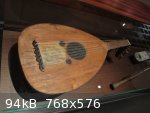| Pages:
1
2 |
jdowning
Oud Junkie
    
Posts: 3485
Registered: 8-2-2006
Location: Ontario, Canada
Member Is Offline
Mood: No Mood
|
|
The old oud (#0164 - late 18th C - early 19th C?)) in the Brussels M.I.M. museum is an example of multiple piece sound board construction. From the
attached image the sound board appears to be assembled from five (?) mismatched pieces - complete with grain deviation, pin knots and slab cut
(tangential axis) pieces! Tangential grain is stiffer than cross grain (radial) cut wood with grain angle at 45° to vertical but not as stiff as
cross grain wood that is perfectly quarter cut (vertical grain) - even so it might have been a valid second choice for the luthier if material
availability had been limited. Pin knots likely have little effect on stiffness.
It is sometimes claimed that a good luthier is able to make successful instruments from pretty much any wood by careful choice.
Of course we do not know how 'good' or 'badly' this instrument sounded to the oud players in its day when strung with gut and/or silk strings. Note
that it has survived to this day most likely because it has been preserved in European instrument collections for the past 200 years or so.

|
|
|
hamed
Oud Junkie
    
Posts: 295
Registered: 1-18-2005
Location: Seattle, Washington
Member Is Offline
Mood: Iss'al rouhak
|
|
I see, thank you for the clarification.
|
|
|
jdowning
Oud Junkie
    
Posts: 3485
Registered: 8-2-2006
Location: Ontario, Canada
Member Is Offline
Mood: No Mood
|
|
This is an old thread but I came across this article the other day that may be of general interest. It clearly explains the phenomenon of spiral grain
growth in trees - particularly softwoods - and so adds to information provided earlier in this thread. The article is mainly concerned with selection
of lumber for structural purposes (buildings) but the same material property considerations strength, stiffness etc also applies to sound board wood
selection.
It also helps to explain why sound board woods can vary so much in acoustic properties when cut from different parts of the same tree - even across
the same cross section of a tree.
Spiral growth - particularly the unstable left hand spiral ('with the sun') is a weakness and obstruction to optimum sound transmission to be avoided
in a sound board.It may be positively detected by initially splitting a tree section into smaller pieces before sawing into sound boards. This way
pieces from the mid portions of a log that may exibit perfectly straight grain (unlike the inner and outer portions that will have spiral grain to
some extent) can be identified as potentially prime sound board material.
Of course, once sound boards have been thinly rough sawn for sale by the luthier supply companies, an instrument maker has no way of knowing by visual
inspection whether there is spiral growth present (except possibly by looking for light reflection variations between bookmatched pieces once they
have been planed smooth). Non destructive mechanical tests on thinly sawn sound board material to determine material properties are also difficult.
On the other hand smaller billets of wood (but too small in section to be cut into two piece sound boards) may be more easily tested by fairly
primitive methods such as dropping the pieces onto a hard surface - end on - to see how high they will bounce - a crude measure of elasticity and
stiffness, the higher the bounce the better. Or by tapping the end to listen for a clear sound. Tests that require some degree of experience, however.
More sophisticated (but low cost) testing may involve measuring the relative speed of sound to determine stiffness etc. Such tests can only be
successfully conducted on small billets of wood not thin sound board blanks
http://www.mikeouds.com/messageboard/viewthread.php?tid=12819
The acid test would then be to split the billet to test for spiral grain before sawing to pieces of width suitable for multipiece sound board
construction.
[file]36323[/file]
|
|
|
| Pages:
1
2 |